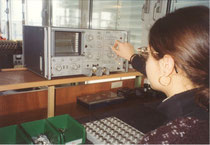Transistor Selection

The above picture shows the selection of specially made power transistors done on a high power curve-tracer. After the chips have passed the specific tests at the foundry every single
semiconductor is first pre-selected and thereafter measured and analysed.
This is done on the curve-tracers, testing five different parameters under static and - unique to FM ACOUSTICS - dynamic conditions. This transistor selection is far better than the typical
"transistor matching" that simply put the transistor on a "Beta" meter where only a static single voltage and a single current value is measured.
Transistor may have the same Beta at this one specific voltage and current, but they may be much different at other voltages and currents. If standard transistors that have undergone such a
simple ''Beta'' test are used in an amplification stage, non-linearities are unavoidable; these non-linearities then have to be compensated with error correction circuitry, a unsatisfactory
approach as such error correction circuitry invarably compounds various other negative effects on reproduction quality.
Most of these errors are not measurable with the currently available instruments - which are only capable of analysing static signals. Music signals, however, are dynamic and cover a large
frequency range, which means that measuring instruments (whilst useful for quality control) do not give an accurate representation of how a product will reproduce music.
FM ACOUSTICS takes a totally different approach. Every single transistor is tested with the utmost care and thereafter selected by hand over the entire voltage and current range. Using such
specially selected transistors, distortion created in the positive and negative sides of the amplifier stage cancels out, resulting in a stage that is inherently distortion-free.
Through cascading such distortion-free amplification stages, error correction circuitry can be avoided resulting in dramatically better performance. This proprietary technology assures that the
usual effects - like instability, frequency-dependent feedback, increased distortion and other negative influences on the audio signal - cannot occur. Dynamic and transient behaviour is
dramatically better.
These selection procedures are very time-consuming and a considerable percentage (anywhere from 40% to 95%) of the devices must be rejected because they do not attain the FM ACOUSTICS standards.
